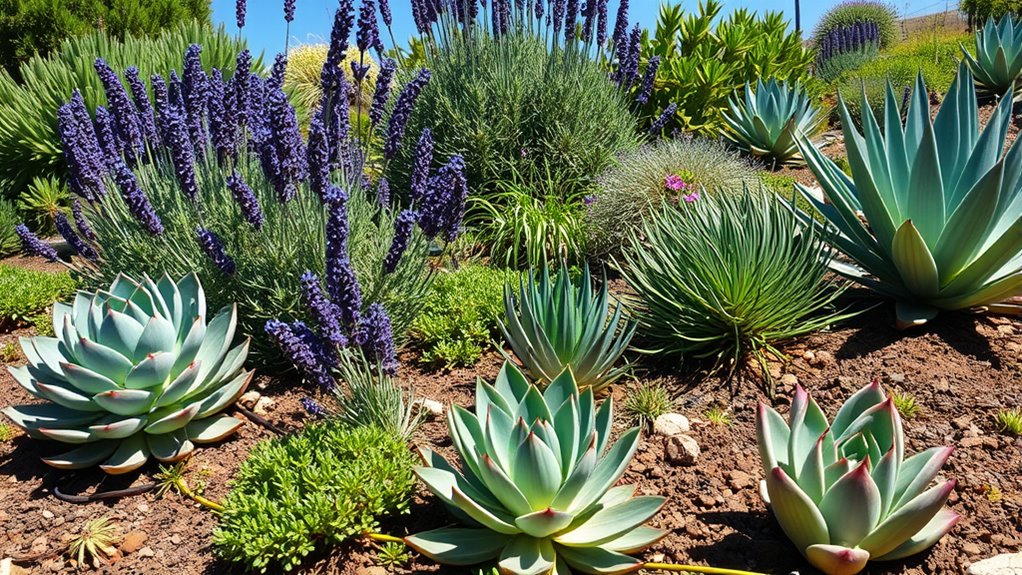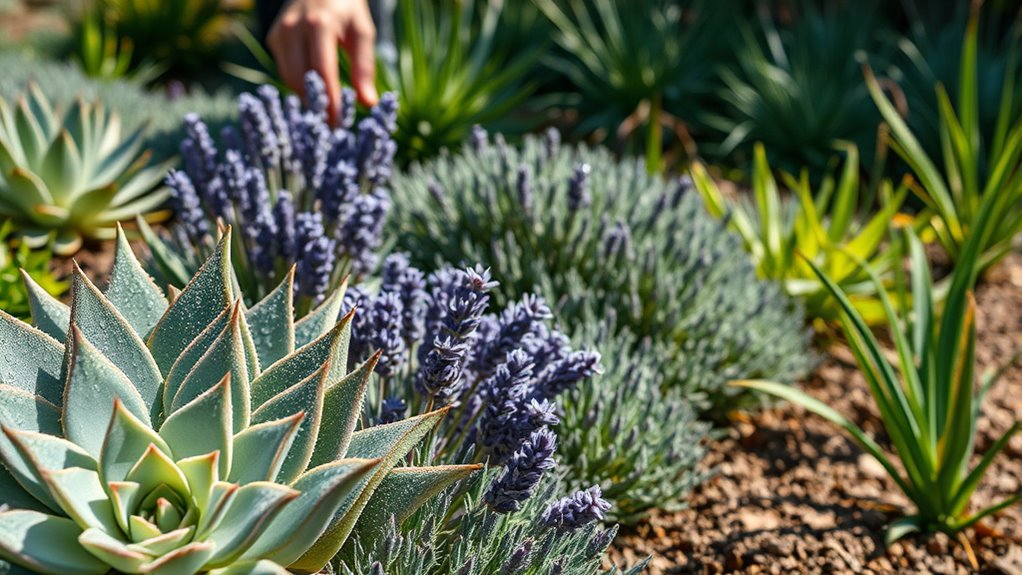For drought-tolerant plants, you should typically water them every 2 to 3 weeks, but adjust based on your climate, soil, and plant needs. During hot, dry spells or sandy soils, more frequent watering every 10 to 14 days may be necessary. Cooler or humid conditions may extend the interval. Keep a close eye on soil moisture to avoid overwatering. Continue exploring for more tips on adapting your care to keep your plants healthy.
Key Takeaways
- Water drought-tolerant plants every 2 to 3 weeks, adjusting based on climate, soil, and plant needs.
- Check soil moisture regularly, watering only when the top inch feels dry.
- Increase watering frequency in hot, dry, sandy soils; reduce in cooler or humid conditions.
- Fertilize minimally in early spring and mid-summer; avoid late-season fertilization.
- Monitor environmental conditions and soil moisture cues to prevent overwatering or drought stress.
Optimal Watering and Care Schedule for Drought-Tolerant Plants

Managing drought-tolerant plants effectively requires a practical schedule that balances their low water needs with healthy growth. These plants are designed to thrive with minimal watering, but understanding the right watering frequency is vital to avoid under- or over-watering. Typically, you should water drought-tolerant plants once every 2 to 3 weeks, depending on the climate, soil type, and the specific plant species. During hot, dry periods or in sandy soils that drain quickly, you might need to water a bit more often, perhaps every 10 to 14 days. Conversely, in cooler or more humid conditions, stretching the interval to 3 weeks or more is usually sufficient. The key is to monitor soil moisture—wait until the top inch feels dry before watering again. This approach guarantees you’re providing enough moisture without encouraging root rot or fungal issues. Ensuring proper soil drainage and utilizing well-draining soil mixes for drought resistance can also help maintain optimal moisture levels.
Fertilization timing plays a vital role in supporting drought-tolerant plants’ health. Unlike high-maintenance plants that require frequent feeding, these plants generally benefit from minimal fertilization. Typically, you should apply a slow-release, low-nitrogen fertilizer in early spring and again in mid-summer. This schedule provides the necessary nutrients for robust growth while preventing excessive lushness that could make the plants more susceptible to drought stress. Avoid fertilizing late in the season, as this can interfere with dormancy and reduce winter hardiness. When you do fertilize, follow the product instructions carefully, using the correct amount to prevent nutrient runoff and environmental harm.
Frequently Asked Questions
Can Drought-Tolerant Plants Survive in High-Humidity Environments?
Drought-tolerant plants can survive in high-humidity environments, but humidity impact may affect their plant survival. High humidity can promote fungal growth and compromise their drought resilience. To guarantee success, you should improve air circulation around these plants and avoid overwatering. Monitoring humidity levels and adjusting watering routines accordingly will help them thrive despite the challenging conditions. Proper care ensures your drought-tolerant plants stay healthy in humid settings.
How Do I Identify Overwatering or Underwatering in Drought-Tolerant Plants?
Think of your drought-tolerant plant as a delicate dance partner, needing just the right touch. Overwatering makes leaves soggy and yellow, like a wilted crown, signaling it’s drowning. Underwatering leaves it parched, brown, and crispy, like a desert sun. To keep plant health in harmony, observe moisture levels and adjust watering balance accordingly. Staying attentive helps your plant thrive in its resilient, low-water lifestyle without suffering from neglect or excess.
Are There Specific Signs That Indicate My Drought-Tolerant Plants Need Watering?
You’ll notice signs like wilting, leaf discoloration, or soil drainage issues indicating your drought-tolerant plants need watering. If the soil stays dry longer than usual or feels crumbly, it’s a signal to water. Conversely, overly moist soil with plant stress suggests overwatering. Pay attention to these signs, as healthy drought-tolerant plants prefer well-draining soil and minimal watering for ideal growth.
How Does Soil Type Affect Watering Frequency for Drought-Tolerant Plants?
Soil type greatly influences your watering frequency for drought-tolerant plants. Sandy soils drain quickly, so you should water more often using deep, thorough watering methods to prevent dryness. In contrast, clay soils retain moisture longer, meaning less frequent watering is needed. Adjust your watering schedule based on soil composition, ensuring you’re providing enough water to keep roots healthy without overwatering, which can cause issues like root rot.
Can Drought-Tolerant Plants Be Fertilized Regularly Without Overwatering?
Yes, you can fertilize drought-tolerant plants regularly, but you need to balance fertilizer application with your watering schedules. Use a slow-release or diluted fertilizer to prevent overfeeding, which can lead to overwatering or stress. Apply fertilizer sparingly during dry periods, and always wait until the soil is sufficiently moist before watering again. This way, you support healthy growth without risking overwatering or harming your plants.
Conclusion
By following this practical schedule, you’ll guarantee your drought-tolerant plants thrive with minimal fuss. Remember, overwatering can do more harm than good, so stay attentive to their needs. With proper care, they’ll flourish even in dry conditions. Aren’t you excited to enjoy a beautiful, low-maintenance garden that saves water and effort? Keep observing your plants’ responses and adjust your routine as needed, and you’ll enjoy healthy, resilient greenery year-round.










